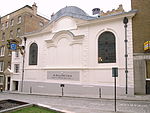St Dunstan-in-the-East
17th-century Church of England church buildingsChristopher Wren church buildings in LondonChurch ruins in EnglandChurches bombed by the Luftwaffe in LondonChurches in the City of London, of which only the tower remains ... and 4 more
Grade I listed churches in the City of LondonParks and open spaces in the City of LondonRuins in LondonRuins of churches destroyed during World War II

St Dunstan-in-the-East was a Church of England parish church on St Dunstan's Hill, halfway between London Bridge and the Tower of London in the City of London. The church was largely destroyed in the Second World War and the ruins are now a public garden.
Excerpt from the Wikipedia article St Dunstan-in-the-East (License: CC BY-SA 3.0, Authors, Images).St Dunstan-in-the-East
St. Dunstan's Alley, City of London
Geographical coordinates (GPS) Address External links Nearby Places Show on map
Geographical coordinates (GPS)
| Latitude | Longitude |
|---|---|
| N 51.509672222222 ° | E -0.082722222222222 ° |
Address
St Dunstan in the East
St. Dunstan's Alley
EC3R 5DJ City of London
England, United Kingdom
Open on Google Maps











